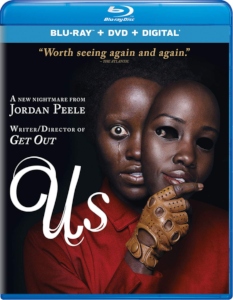Writer-director Jordan Peele’s “Us” reminds me of Alex Garland’s “Annihilation” (2018). Both are followups to a breakthrough piece of chilling sci-fi/horror that I and everybody else loved – “Get Out” (2017) in Peele’s case and “Ex Machina” (2015) in Garland’s. And in both cases, in my opinion, these followup efforts fall flat. Why? Well, it’s impossible to get into a filmmaker’s head. I’m tempted to say the filmmaker is aware of the expectation that he craft high art, and he tries too hard. That’s probably a case of me conflating my expectations with Peele’s – who is simply telling the stories he wants to tell — but I can’t deny that I found “Us” to be unengaging, overlong and even boring.
(For Summer’s positive and spoiler-light review of “Us,” click here.)
In “Us,” everyone is a cipher, not just Addy Wilson (Lupita Nyong’o), who as a child (Madison Curry) in the 1980s comes back wrong from a Santa Cruz boardwalk house of mirrors. Her parents put her into ballet classes and Addy gradually recovers, although in present day she’s not thrilled with her husband Gabe’s (Winston Duke) notion that they spend the day at the boardwalk with their children, Zora (Shahadi Wright Joseph) and Jason (Evan Alex).
Here and there, the Wilsons seem like a normal, warm family. But Nyong’o is such a strong acting presence that “Us’s” overall tone is one of cautious, timid distance, even within the family. Addy doesn’t fully engage with anyone, including the Wilsons’ supposed best friends – Kitty (Elisabeth Moss) and Josh (Tim Heidecker) and their twin teen girls. Addy isn’t good at “just talking,” she admits to Kitty.
As I watched “Us” and failed to get hooked as I did with “Get Out,” I thought: “Afterward, I’ll appreciate all the symbolism and find this to be a great film, even though I’m kind of bored while watching it.” “Us” is loaded with moments that you know must be symbolizing something, even if you don’t understand right away. A “Hands Across America” TV ad for the fight against hunger plays in the 1986 flashback. A homeless man on the beach holds a sign indicating a Bible verse.
“Us” is less of an overt commentary on race relations than “Get Out” is, but it stretches more to achieve its statements, whether about the specifically black experience or the human experience.
The film opens with a title card telling us that the U.S. includes a lot of abandoned underground tunnels.
(Spoilers follow.)
In the overlong conclusion, we learn that doubles of everyone live in these tunnels. Since “Us” is a symbolism-based film, it’s not necessarily a problem that the “how” is never explained. (How did these doubles come to be? And how do they survive for at least three decades without anyone noticing?) But even on that level, it’s still more weird than fascinating.
A lot of messages are close to the surface if you want to engage with them. Most obviously, like in “The Time Machine,” the upper class (literally above ground) ignores the lower class (literally below ground). In “Us,” those others look exactly like us, so the Wilson family is forced to confront the thin line wherein they got the lucky draw with their lot in life. (They don’t have time for that in the narrative, though, as this is structurally a horror/thriller. They are busy fighting for their lives.)

When the underground dwellers – all wearing the same color, red — emerge and link hands across America, they are viewed as a threat, with concerned news reports and helicopters (from the media, or perhaps military choppers) flying overhead, monitoring the human chain. This could be read as the way protests or political movements for equality are viewed with suspicion and fear, because the lower class has broken free of its expected behaviors.
As the Wilsons fight the doppelgangers, “F*** the Police” plays over the house’s Alexa-style sound system. Muddling the message of “Us,” the doubles – while they are indeed oppressed and broadly sympathetic — are also the traditional violent and scary villains. Granted, some of this strangeness is ironed out when we learn that “Addy” is actually not really Addy, but rather her doppelganger, Red; they switched places as kids. Still, Peele’s crisp message in “Get Out” gives way to something stranger and more open to interpretation in “Us.”
Mike Gioulakis’ lush cinematography and, even more so, Michael Abels’ score try to make “Us” better than it really is. At times, the music is surprisingly understated when a standard horror film would be bombastic. Later, Abels goes with foreboding and weird sounds to accompany wild strings of imagery. For instance, as Red performs ballet for audiences as a child, Addy does the same underground, in a mirror image.
Or maybe Red is the puppet and Addy is the marionette. Or maybe I’ve given one level too much thought to “Us,” which is a prime example of a film that’s more interesting to read about and think about than it is to watch. Films can work on both levels, as proven by “Ex Machina” and “Get Out.” But to me, “Us” – never quite scary, always a bit too weird to engage with — is more something to think about than it is to enjoy in the moment.

